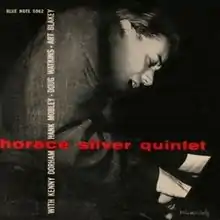Horace Silver and the Jazz Messengers
Horace Silver and the Jazz Messengers is a 1956 repackage of 1954 and 1955 releases by jazz pianist Horace Silver with drummer Art Blakey as well as Hank Mobley on saxophone, Kenny Dorham on trumpet, and Doug Watkins on bass. By the time of this repackage, this quintet had named themselves the Jazz Messengers, and the band name on the re-release reflected that. These recordings helped establish the hard bop style. Scott Yanow on Allmusic describes it as "a true classic".[4] Originally released as an LP, the album has subsequently been reissued on CD several times.
| Horace Silver and the Jazz Messengers | ||||
|---|---|---|---|---|
 | ||||
| Compilation album by | ||||
| Released | October 1956 | |||
| Recorded | December 13, 1954 (#1-3, 8) February 6, 1955 (#4-7) Van Gelder Studio, Hackensack | |||
| Genre | Jazz, hard bop | |||
| Length | 43:50 | |||
| Label | Blue Note BLP 1518 | |||
| Producer | Alfred Lion | |||
| Horace Silver chronology | ||||
| ||||
| Jazz Messengers chronology | ||||
| ||||
| Horace Silver Quintet | |
|---|---|
 | |
| Studio album by | |
| Released | 1954 |
| Recorded | December 13, 1954 Van Gelder Studio, Hackensack |
| Label | Blue Note |
| Horace Silver Quintet, Vol. 2 | |
|---|---|
 | |
| Studio album by | |
| Released | 1955 |
| Recorded | February 6, 1955 Van Gelder Studio, Hackensack |
| Label | Blue Note BLP 5058 |
| Review scores | |
|---|---|
| Source | Rating |
| Allmusic | |
| The Rolling Stone Jazz Record Guide | |
| The Penguin Guide to Jazz | |
Background
Horace Silver and the Jazz Messengers was the first 12" Blue Note album released under Silver’s name. The album is a reissue of two previous 10" LPs -- Horace Silver Quintet (BLP 5058) and Horace Silver Quintet, Vol. 2 (BLP 5062) -- and the first sessions in which he used the quintet format which he would largely use for the rest of his career. The music on the album mixes bebop influences with blues and gospel feels.
One of the most successful tunes from the album, "The Preacher", was almost rejected for recording by producer Alfred Lion, who thought it was "too old-timey", but reinstated at the insistence of Blakey and Silver, who threatened to cancel the session until he had written another tune to record in its place if it wasn’t included.[5] According to Silver, the track showed that the band could "reach way back and get that old time, gutbucket barroom feeling with just a taste of the back-beat".[6]
Track listing
All tracks are written by Horace Silver except where noted..
| No. | Title | Length |
|---|---|---|
| 1. | "Room 608" (*) | 5:22 |
| 2. | "Creepin' In" (*) | 7:26 |
| 3. | "Stop Time" (*) | 4:07 |
| 4. | "To Whom It May Concern" (**) | 5:11 |
| No. | Title | Writer(s) | Length |
|---|---|---|---|
| 5. | "Hippy" (**) | 5:23 | |
| 6. | "The Preacher" (**) | 4:18 | |
| 7. | "Hankerin'" (**) | Hank Mobley | 5:18 |
| 8. | "Doodlin'" (*) | 6:45 |
(*) Originally released on 10" LP Horace Silver Quintet (BLP 5058)
(**) Originally released on 10" LP Horace Silver Quintet, Vol. 2 (BLP 5062)
Personnel
Performance
- Horace Silver - piano
- Kenny Dorham - trumpet
- Hank Mobley - tenor saxophone
- Doug Watkins - bass
- Art Blakey - drums
Production
References
- Allmusic review
- Swenson, J., ed. (1985). The Rolling Stone Jazz Record Guide. USA: Random House/Rolling Stone. p. 181. ISBN 0-394-72643-X.
- Cook, Richard; Morton, Brian (2008) The Penguin Guide to Jazz Recordings (9th edition). Penguin. p. 1298.
- Allmusic: Horace Silver and the Jazz Messengers – Review
- Silver, H. (2007): Let's Get to the Nitty Gritty: The Autobiography of Horace Silver, University of California Press, p. 79-80
- Rosenthal, D. H. (1992): Hard Bop: Jazz and Black Music, 1955-1965, OUP, p. 38